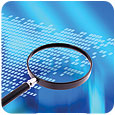Managing Coating Analysis Data

Modern digital gauges such as coating thickness gauges, relative humidity gauges and surface profile gauges incorporate features that aid in the collection and management of data on coatings applied to a variety of metal products and components. Memory in these gauges allows readings to be stored in batches for analysis and archiving; onboard calculation capabilities allow statistical information to be displayed and stored for decision making and further analysis; and data output allows the gauge memory to be uploaded to a PC for analysis, reporting and archiving in an efficient and accurate manner.

Advanced coating thickness gauges, such as the Elcometer 456 shown above, are designed as both an integral probe unit and a separate probe unit so that the user can select the most suitable gauge for the measurement application.
Coating Thickness Measurements
Some of the most advanced coating thickness gauges are designed as both an integral probe unit and a separate probe unit so that the user can select the most suitable gauge for the measurement application. Some of these instruments also feature maximized capacity for data storage.Some coating thickness instruments have the option of two measurement systems: magnetic induction for measurement of coatings on ferrous metal substrates and eddy current for measurement of coatings on nonferrous substrates. A dual-principle option combines ferrous and nonferrous measurement principles in a single probe that automatically determines and displays the substrate. These probes mainly are used for applications where mixed metal substrates are used, for example automotive bodies, where steel and aluminum alloys are used for different body components for the vehicle.
The separate probe gauge design has probes that are programmed for interchangeability, so different probe sizes and ranges can be connected to a single gauge to maximize the flexibility of the gauge in its applications, such as on small parts or difficult-to-access areas. Probes are not interchangeable on integral probe designs, but these gauges can be used one-handed and are pocket-sized for convenience in many field applications, particularly for large areas such as ships hulls or the easily accessed areas of a vehicle body.
Some of the latest versions of coating thickness gauges with memory also have Bluetooth® connectivity to allow wireless communication of readings over a distance of up to 49 ft to a PC using proprietary software for coatings data management. Some instruments allow readings to be sent directly to data devices such as PDAs and mobile phones and are used in conjunction with Windows® Mobile Software.
Data Collection
The memory of some of the most advanced coating thickness gauges is organized for collecting batches of readings, and each batch automatically is given unique batch identification numbers in the range of 1 to 999. Each batch can have unique calibration adjustment settings so that different parts or areas of the job in hand can be given an adjustment that is relevant to the work for maximum accuracy of thickness readings. For example, rounded items will have a different calibration adjustment than flat areas, and rough areas (shot or grit blasted) will have a different calibration adjustment than smooth areas.With a capacity for up to 40,000 readings in 999 batches, up to 250 of which can be active at any time, these advanced instruments can collect large volumes of data in the field. The reading rate of these gauges is greater than 60 readings per minute, so at full speed the gauge memory will take more than 11 hours to fill. However, these gauges also have data output capability, so that the memory can be uploaded conveniently to a computer either as a data transfer to a spreadsheet or more usefully to a data management program.

Some of the newest dewpoint meters, such as the Elcometer 319/2 shown above, have been designed to incorporate all relevant climatic condition monitoring in a single gauge.
Data Transfer
Data transfer uses a Windows-style program running in the background to send the readings from the memory to the spreadsheet as a column of values. When the coating thickness gauge is selected from the set of gauge options in the transfer program, an operations wizard is activated to take the user through the steps to upload the data. When the readings have been uploaded into the cells, the calculating and presentation features of the spreadsheet can be used to analyze the data, calculate statistics and produce the required charts. The setup includes the appropriate RS 232 protocol, including the data transfer rate (the number of data bits, number of stop bits, parity, hand shaking and baud rate [19200 baud]).It is possible to construct a job record so that the reading number corresponds to a location on the job. The value in the cell can then be related to similar cells to drill down and present information from particular areas. For example, for a coating thickness survey, it is possible to designate the first batch to be the thickness of the galvanized layer, the second batch to be the primer thickness readings, the third batch to be the basecoat and the fourth batch to be the topcoat. If the readings are taken at the same points on the structure each time, the spreadsheet can be used to calculate the individual layer thicknesses by subtraction, i.e. the thickness of the topcoat is batch 4 minus batch 3.
Alternatively, for thickness readings on an I-beam, readings 1-10 can be taken on the web, 11-20 on the upper flange and 21-30 on the lower flange, etc., so that each group can be separated and the average, standard deviation, highest, lowest and range of readings can be calculated and presented using the spreadsheet features.
Dewpoint and Surface Profile
Some of the newest dewpoint meters have been designed to incorporate all relevant climatic condition monitoring in a single gauge. Determining the presence of moisture and condensation on surfaces can help to prevent potential coating flaws during the service life of the coating. These gauges measure air temperature (TA), relative humidity (RH), and surface temperature (TS), and then automatically calculate the dewpoint temperature (TD), as well as the difference between the dewpoint and surface temperatures (ΔT). With a reading memory of up to 12,000, these instruments remove the potential for errors when recording values or determining dewpoint. Some instruments also have an additional docking unit that serves as an interface between the gauge and a PC. Using proprietary software, readings can be stored and used to create reports.Some of the latest surface profile gauges use the well-established peak-to-valley height surface profile measurement technique with a tungsten carbide tip to measure the distance to the bottom of the valley relative to a stainless steel foot that sits on the top of the peaks. These instruments feature an electronic design that incorporates memory and statistical calculations, and readings can be downloaded to a PC in seconds.
The most advanced versions of these gauges can store up to 50,000 readings in up to 999 batches, and readings can be taken at a rate of more than 40 per minute, making them useful for automated steel cleaning processes. The instruments calculate and display the statistics, mean, number of readings and other data points in real time. The assessment of a blast-cleaned surface can be completed quickly by taking up to 15 readings over an area approximately 6 in. in diameter and using the mean of these readings as the typical peak-to-valley height for the profile.

A run chart shows all the readings in a batch in sequence so that trends can easily be seen.
Data Management
When data is collected in batches, the analysis and presentation can be enhanced by the use of effective data management software. Readings can be collected in a gauge that is remote from the computer and then uploaded as a batch or batches for archiving, analysis and presentation.Modern data management software has a number of gauge transfer options pre-programmed to simplify the transfer of data into the database. It also includes a number of database management features to allow, for example, batches to be combined and notes to be added to make the information more meaningful when further analysis is carried out.
A number of charts can be displayed to present the data. For example, a run chart shows all the readings in a batch in sequence so that trends can easily be seen. A histogram can be calculated and presented with a normal distribution superimposed so that the spread of data values can be compared easily to the target values and upper and lower limits. A lognormal chart can be used to determine how much variation there is in the data set from the statistical normal distribution, to determine the degree of control exhibited by the coating process.
In some cases, specialized charts can be set up so that the specified coating thickness is equal to the lower drawing limit. In this way, 80% of target value becomes the lower specification limit and the 120% of target value becomes the upper specification limit. The charts then present the data relative to these values as required for assessment either to SSPC PA-2 or to ISO 19840.
Data uploaded to the data management software can be edited, but the most advanced of these programs records the edit so that fabrication of data to pass or fail inspection criteria is not possible. Values and limits can be changed on a “what if” basis so that the effects of the changes can be seen. However, the batch record will carry the note “(Edited)” so that the change is visible.
Databases can be managed through the program so that batches of readings can be moved to existing folders or new folders created from within the program to simplify the archiving of data for future reference.
A Paperless System
The management of inspection data for coatings is made simple and effective by the use of data transfer features built into modern electronic inspection gauges. Spreadsheets offer a degree of flexibility in data analysis using the calculation power of the spreadsheet features. However, an effective data management program offers enhanced reporting features and allows simple data archiving with database management features.In the future, more gauges will have Bluetooth connectivity, allowing comprehensive reports on inspection outcomes. This capability, in turn, will allow data collection through data transmission devices such as PDAs and mobile telephones, which will make field inspection more effective.
Quality control for coating processes has been shown to yield benefits in terms of the service life of coatings, and paperless inspection data will pass these benefits along to more coating processes.
For more information, call 011.44.161.371.6000, e-mail sales@elcometer.com or visit www.elcometer.com.
Looking for a reprint of this article?
From high-res PDFs to custom plaques, order your copy today!




